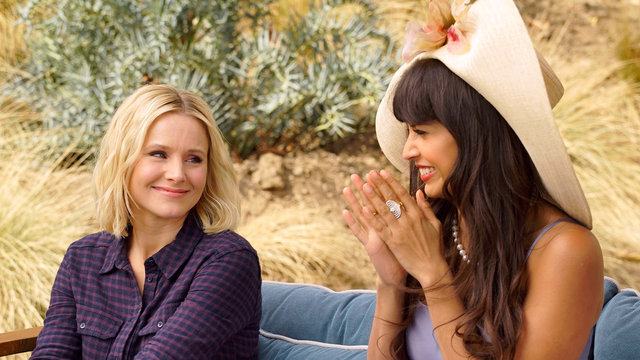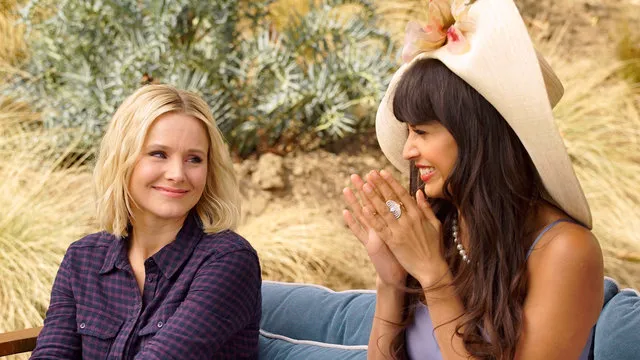Editor’s note: spoilers for The Good Place follow.
NBC’s new comedy The Good Place, starring Kristen Bell and Ted Danson, is about what it means to be a good person. As Michael (Danson) explains in the pilot, when someone dies, their actions are measured for the good or bad effect they had on the rest of the world. The very top people, the good-est of the good, get to come to the Good Place. Everyone else, the only kinda good and the truly bad, goes to the Bad Place. In the Bad Place, there are screams and terror and car crashes. In the Good Place, there is unlimited frozen yogurt, you meet your true soul mate, and you live in a house perfectly suited to your personality. It’s a paradise for ethics professors, charity workers, and Buddhist monks to live together in perfect bliss and harmony.
But Heaven isn’t all it’s cracked up to be for Eleanor Shellstop (Bell)…because she’s not supposed to be there. Michael got her name right, but Eleanor wasn’t a human rights lawyer who saved Ukrainian orphans; she worked for a scam company selling fake medicine to the elderly and refused to boycott a coffee shop that sexually harassed its workers. Eleanor learns she must change her name-calling, shrimp-stealing ways when her bad behavior throws off the Good Place’s balance and causes Michael’s delicate neighborhood to crumble. If anyone figures out she’s the bad egg making trash fall from the sky and giraffes run amok, she’ll be thrown out to suffer for eternity.
The role of Eleanor gives Bell plenty of opportunities to stretch her comedic muscles in a direction that isn’t as cutesy as the roles she typically plays. Usually typecast as a lovable goofball, here she gets to make obscene gestures at a hot bartender and tell an environmentalist to “eat [her] farts.”
But Eleanor is more than Bell’s performance; she’s a fantastic character because the show focuses not on what makes her a bad woman, but what makes her a bad person. Eleanor is selfish, corrupt, and cruel, but her badness isn’t gendered in the way you often see with women in the media. It isn’t her inclination to “bang it out” with a hot bartender that makes her a bad person; it’s blowing off her coworkers who needed her to be their designated driver. It isn’t her desire to have fun and party, it’s that she doesn’t take responsibility for how her actions affect others. You could cast a man in the same role and it would still make sense because her badness isn’t tied down to tired ideas of what a woman should be or do.
Eleanor’s soulmate, former moral philosophy and ethics professor Chidi (William Jackson Harper), is initially torn between telling a lie to help Eleanor and sending her to damnation with the truth, but eventually decides to keep her secret and be her “goodness coach.” He teaches her Aristotelian ethics, which dictate that if you do good things, whether or not you actually want to do them, you still count as a good person. The more you try to be good, the better person you become. This seems to hold true for Eleanor’s neighbor Tahani (Jameela Jamil), who is arrogant and condescending, but dedicated her life to helping others. And so, Eleanor struggles to choose to do the right thing instead of the thing she wants to do.
The third episode uses Eleanor and Tahani to explore society’s tendency to pit women and girls against each other as they fight to be the “best.” Tahani Al-Jamil, which translates to “Congratulations Beautiful,” is glamorous, rich (in death and in life…apparently her godmother was Princess Diana), gorgeous and, of course, good. And she knows it. Her tendency to brag and condescend makes her a perfect target for Eleanor’s ire. It’s the perfect setup for the typical frenemy tropes we’re so used to seeing in the media. Tahani versus Eleanor represents the plot of almost every teen movie ever made: Cool Girl vs. Girly Girl. But The Good Place decides to subvert this trope while still giving Eleanor space to be selfish and for Tahani to be self-aggrandizing.

When Tahani brings Eleanor a plant as a gesture of gracious good will, Eleanor decides to make it her mission to ferret out Tahani’s dark secrets. But not only does she find no evidence of evil, she finds herself making a friend out of a frenemy. Midway through the episode, Eleanor admits to Chidi that her vitriol towards Tahani is just the insecurity she always feels when confronted with someone she perceives as better than her. At the end, Eleanor finds Tahani crying. She’s upset that her Buddhist monk soul mate, Jianyu, won’t break his vow of silence to talk to her. Instead of tearing her down, Eleanor comforts Tahani and tells her how amazing, kind, and beautiful she is, and that Jianyu would be nuts not to adore her. When she gets home, she finds that the plant, the one that burst into flame when Eleanor admitted she’d stolen Tahani’s diary so she could find some dirty laundry, has grown to twice its size.
Despite all her goodness brownie points, Tahani can be obnoxious. Despite all her rough edges and self-centered behavior, Eleanor is “a medium person” just trying to protect herself. They’re complex women who exist despite pervading cultural ideas that women are either perfect or worthless, and their goodness or badness isn’t pigeonholed into sexist tropes. After all, separating people into “good” and “bad” is no simple task.
A show called The Good Place is ripe for discussion of what “goodness” means, and in less than 90 minutes, it’s already covered Aristotle and Kant. It’s exciting to see a show recognize that while morality is complicated, women shouldn’t have to follow a different set of rules.
image via NBC
Want more stories like this? Become a subscriber and support the site!
Chelsea Ennen holds a master’s in Contemporary Literature, Theory, and Culture from King’s College London. Her writing has appeared on The Female Gaze and HelloGiggles. She is an editorial fellow at The Tempest, and the fiction editor at the Kaaterskill Basin Literary Journal. Follow her on Twitter (@ChelseaEnnen) for updates on her creative work and inane pop culture commentary.
—The Mary Sue has a strict comment policy that forbids, but is not limited to, personal insults toward anyone, hate speech, and trolling.—
Follow The Mary Sue on Twitter, Facebook, Tumblr, Pinterest, & Google+.








